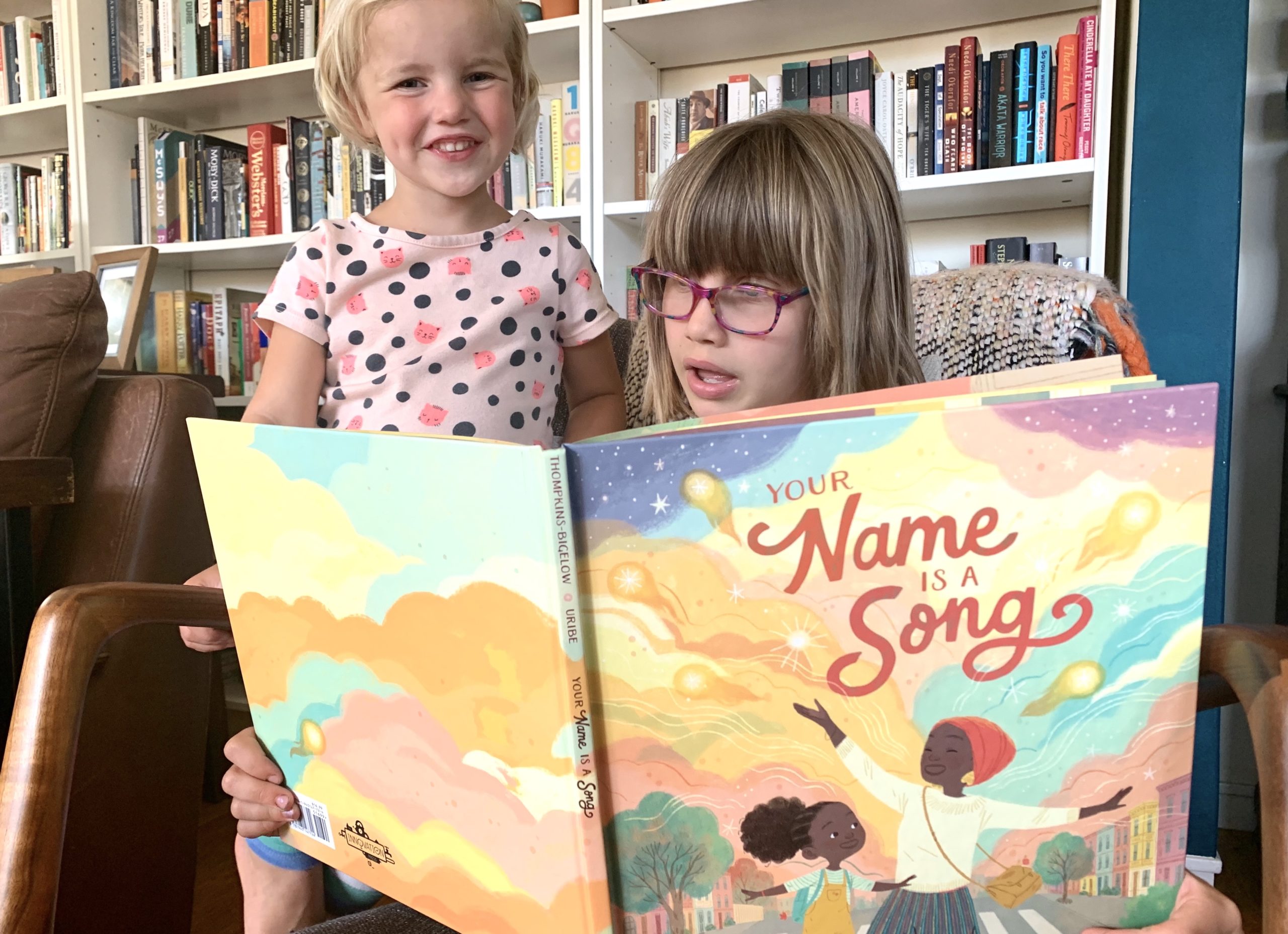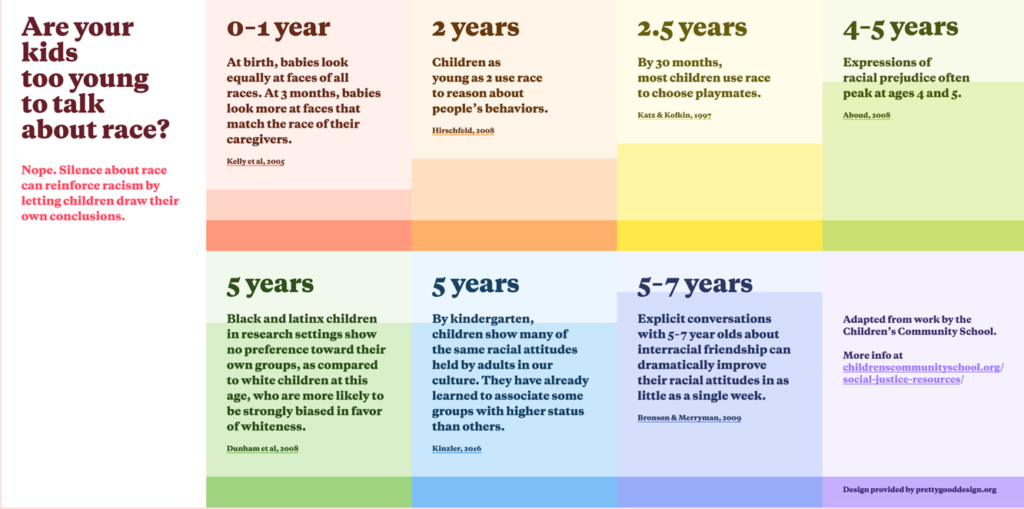Blog
Picture Books to Teach Anti-Racism
Share
Post by Cassie Perham, OLC Co-Director
 Cassie’s two daughters ages 3 and 6 reading the book “Your Name is a Song” by Jamilah Thompkins-Bigelow
Cassie’s two daughters ages 3 and 6 reading the book “Your Name is a Song” by Jamilah Thompkins-Bigelow
I’ve spent nearly a decade working with the Oakland Literacy Coalition. My husband runs a bookstore company. It’s no surprise that books play a large role in our lives (and on the wall space in our little house). With my two young daughters, picture books have been important tools in how we’ve built their knowledge of the world, navigated new experiences, and developed self-awareness. Whatever the issue – from becoming a big sister to making friends at school to learning what it means to be brave – you can bet we’ve read a book about it.
Reading stories together as a family is powerful not only for the new ideas and perspectives books can introduce but also for the questions and conversations that they can spark. I’m consistently amazed at the insight, curiosity, and depth that my kids bring to the discussions about what we’ve read. I’ve learned to trust in their ability to engage, synthesize, and make meaning and to see my role as scaffolding and contextualizing what and how they learn rather than shielding them from hard or painful truths.
With the Movement for Black Lives catalyzing a public reckoning about racism in our country, my family is one of many having frequent discussions about racial injustice. Below I offer a collection of racially diverse and anti-racist picture books that I have found useful in engaging my kids in understanding race, racism, and privilege and that I hope might be helpful to yours. I also offer some of the considerations that I and my OLC colleagues think about when selecting books and using them as entry points for these necessary but often challenging conversations.
Ultimately these are conversations that we have to be having to prepare our children to continue the work towards liberation and justice. Our kids – whatever their ages – are ready if we approach them with trust and openness.
“In a racist society, it is not enough to be non-racist.
We must be anti-racist.”
—Angela Davis
Kids absorb and interpret messages about race whether or not we acknowledge and address it directly. To teach children to be anti-racist, I believe it is necessary that we have explicit and frequent conversations about race, structural oppression, and the moral responsibility of white and non-Black families of color to confront anti-blackness and dismantle white supremacy.
And these conversations can’t start soon enough. Studies shows that kids internalize messages about race and begin to develop racial biases by the time they’re toddlers. It can feel hard to know where to start or how to go about introducing these topics with very young children. But it’s precisely by introducing concepts of race and identity at a very young age that we can most effectively lay the foundation for more complex conversations about oppression, privilege, and justice.
 Are your kids too young to talk about race infographic
Are your kids too young to talk about race infographic
Anti-Racism through Children’s Books
All kids deserve books that positively reflect and affirm their identities, give voice to their history, and embrace their humanity in all its fullness. Reading books with diverse characters builds empathy across racial difference, challenges stereotypes, and de-centers whiteness as the neutral normal in books and media. Books also help provide the history and context that children need to understand racism as a systemic issue that extends far beyond individual values, behaviors, and prejudices.
For white children like my own, it’s especially important to include books that explicitly deal with whiteness and white privilege. These challenge the pervasive concept of whiteness as a non-racialized identity and help guard against implicit messaging that racism is a problem affecting Black, Indigenous, and People of Color (BIPOC) that needs to be empathized with rather than a system that white people created, benefit from, and bear responsibility for rectifying.
Considerations for Selecting Books
- Books with BIPOC characters that are affirming and anti-bias – that do not employ stereotypes or tokenism and are not monolithic in the narratives they share. We aim for a balance of books that directly embrace and celebrate characters’ racial identities along with books that center racially diverse characters but where race is not an explicit theme.
- Own Voices stories — books by authors and illustrators who share the identities of their main characters. It’s important for stories to be told by those who bring the wisdom of lived experience and to put resources towards BIPOC authors and illustrators — especially given the racial disparities in publishing.
- Books that deal directly with racism, white supremacy, white privilege, and racial justice. It’s important to have books that are specific in talking about racial injustice, white supremacy, and white privilege throughout history and to the present day. Don’t limit selection to books about slavery or the Civil Rights Movement — while the history is necessary, it’s important that kids don’t see racism as only a problem of the past. Share stories of people who organized and resisted to create change throughout history.
Using Books To Open Conversations
- Especially with very young kids, a great place to start is by naming and celebrating difference. Model that it’s okay to notice difference and that it makes our world a more interesting and beautiful place. Help kids understand that different groups of people have different experiences, challenges, and advantages in how we navigate and exist in society.
- Ask questions, make observations, and talk about feelings. “Do you think that was fair? How do you think she felt? What would you have done in that situation? What do you think should have happened instead? How did hearing this story make you feel?” Empathize and hold space for the intense feelings – anger, sadness, shame, fear – that these conversations will likely bring up. Model critical reading by making observations like, “I notice that all of the characters in this book were white. What do you think about that?”
- Use stories to practice for real-life situations. Talk through scenarios in stories to help kids get comfortable with identifying racism and ways to speak up and take action.
- Remember these are complex and often difficult topics that require ongoing, open discussion. It’s important to normalize talking about race, encourage questions, and scaffold conversations to bring in more nuance and complexity over time. Re-read stories and revisit conversations to give kids time to process, reflect, and bring new insights to the dialogue. Ask questions to explore what kids are taking away from your conversation. Expect that some of their conclusions will miss the mark and need to be re-framed, but try to do so without judgement. Model your own learning and growth.
Edited August 15, 2020: The booklist has been updated to remove the book “Write to Me: Letters from Japanese American Children to the Librarian They Left Behind” by Cynthia Grady due to a problematic reference in the text. Thank you for bringing this to our attention.
Share Your Thoughts
This is far from an exhaustive list of titles or authoritative list of suggestions. I encourage you to share your ideas and recommendations with me at cassie@oaklandliteracycoalition.org.
Additional Resources
- The Brown Bookshelf: Anti-Racist Resources for Children, Families, and Educators
- Social Justice Books: A Guide for Selecting Anti-Bias Children’s Books
- The Conscious Kid: How to Talk to Kids About Race
- Embrace Race: 10 Tips for Reading Picture Books with Children through a Race-Conscious Lens
- NAEYC: Reading Your Way to a Culturally Responsive Classroom
- Finally, check out this list of Black-owned bookstores to support when making purchases



